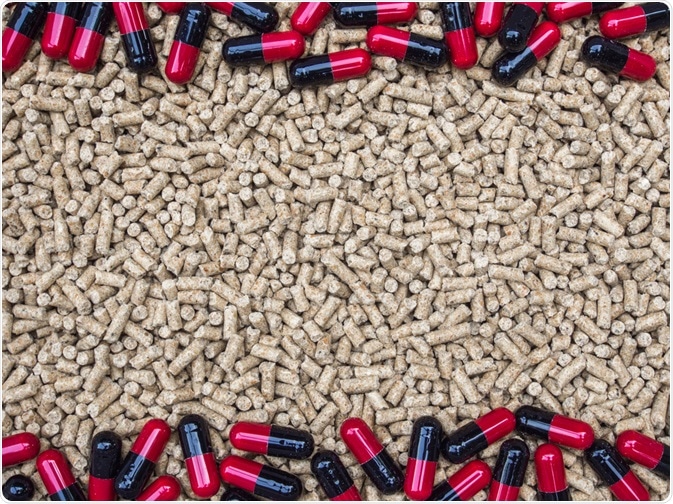Antibiotics are widely distributed to farm animals, which ultimately make their way into the surrounding environment and potentially into food products that are consumed by humans.
Antibiotics are not only distributed to animals in the treatment of existing infection but in a preventative capacity, also being added to feedstock to promote growth and improve its nutrient yield. Many of the antibiotics employed in farming have a similar mechanism of action to major classes of antibiotics prescribed to humans, and thus the risk of human infection by drug-resistant bacteria is heightened.
Change farming and save our antibiotics | Cóilin Nunan | TEDxExeter
Why are preventative antibiotics given to farm animals?
The use of non-essential antibiotics in agriculture varies greatly by region and is especially unregulated in developing countries, intensified by increasingly concentrated farmland use, lack of government policy, and lack of willingness by farmers to risk a drop in profits or change current practices.
The administration of preventative antibiotics also varies greatly by species, pigs receiving around 172 mg/kg of body weight, while cattle and chickens receive 45 and 148 mg/kg, respectively. As the most common mode of administration is by food and water this can lead to a disparity between the number of antibiotics consumed by animals such as chickens, where they compete for food and the diseased are less likely to receive a sufficient quantity, further increasing the positive selection pressure towards resistant bacteria.
Diseased animals are rarely tested for the specific bacterial infection sustained in large-scale agriculture, and further most antibiotic formulas commercially available to farmers do not give a detailed account of what antibiotics they contain. There are many reports of agricultural antibiotic sellers overstating the correct dosage to encourage sales, and farmers in the wealthiest regions generally take a broad-spectrum approach that employs multiple antibiotics.
The increase in the global use of antibiotics reportedly increased by 65% between 2000-2015, and a further 67% percent increase has been projected in high population counties like India by 2030 (Manyi-Loh et al., 2018).
The emergence of resistant strains
Methicillin is a β-lactam antibiotic with a mechanism of action based on the inhibition of penicillin-binding proteins that are involved in the synthesis of the peptidoglycan layer. Methicillin-resistant Staphylococcus aureus was first isolated in 1961, at first only resistant to β-lactam antibiotics, though by the 1980s multi-drug resistant bacteria had begun to emerge more widely.
Vancomycin was the antibiotic of choice in treating multidrug-resistant Gram-positive infections until around 2003 when resistance rapidly developed and rendered the drug useless. The mutations that have brought about drug resistance in these bacteria likely occurred in response to antibiotics administered to humans, though mutations can just as easily occur in zoonotic pathogens.
Genetically modified crops engineered to produce antibiotics innately may also have contributed to the generation of resistant strains of bacteria more recently, and may similarly promote resistance to pesticides in insects.
As there is a constant exchange between soil, plants, and animals, antibiotics and antibiotic-resistant bacteria are able to spread throughout an ecosystem from a single common source. For example, resistance to tetracycline has been widely reported in soil bacteria supplemented with swine manure, and E.coli isolated from a variety of wild sources have demonstrated acquired resistance to antibiotics.
Even very low concentrations of antibiotics in soils have been found to influence the generation of resistance genes, which may then undergo horizontal gene transfer amongst neighboring microbial populations, including those that naturally colonize the human body.
The abundance, enzymatic activity, carbon, and nitrogen metabolism, and other processes of a bacterium may also be altered by the adoption of resistance genes, which may go on to impact the character of the soil with regards to pH and nutritional profile (Cycon et al., 2019).

Image Credit: KOOKLE/Shutterstock.com
How is antibiotic use restricted in agriculture?
In the USA and EU, the use of antibiotics in agriculture is now monitored to ensure that environmental output does not exceed certain limitations, and programs are in place to attempt to reduce the wide-scale use of unnecessary antibiotics. Some specific antibiotics that are most commonly abused in agriculture have been banned in some locations, though the emergence of resistant strains is still on the rise.
The development and deployment of antibiotics against which resistance is difficult or impossible to develop would be critical in the fight against multi-drug resistant bacteria, and most such efforts focus on disruption of the bacterial cell wall, membrane, or other vital bacterial cell machinery.
Other more complex strategies include DNA and mRNA vaccines that would induce an immune response against the bacteria, bacteriophage therapy wherein a virus is designed to infect and destroy target bacteria, or the use of gene-editing technology to attempt to replace the resistant population with an engineered non-resistant form (Mann et al., 2021).
Further Reading